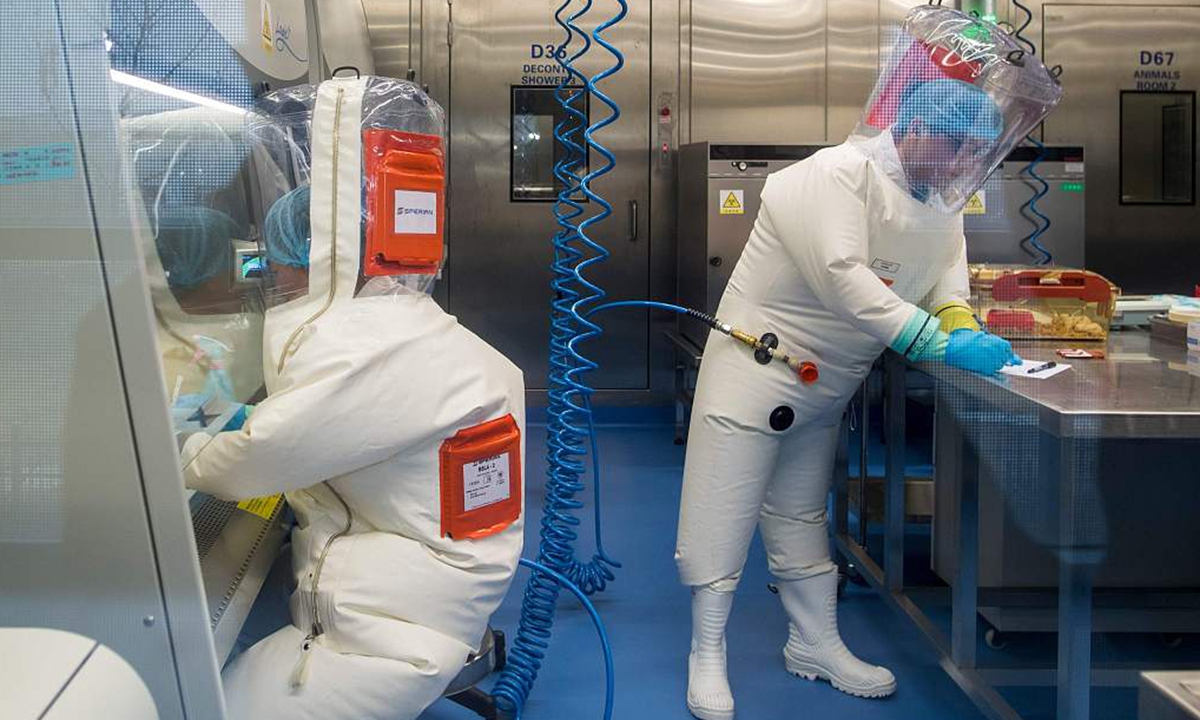
Researchers work in the P4 lab in Wuhan Institute of Virology, Wuhan, Central China’s Hubei Province on February 23, 2017. Photo: CFP
Researchers from the Wuhan Institute of Virology and the University of Chinese Academy of Sciences published a report that further refutes the highly hyped theory that the virus came from the laboratory. They identified a new SARS-CoV-2-related virus lineage from bats discovered in 2015 in Mojiang county, Southwest China's Yunnan Province.
The report, entitled "Identification of a novel lineage bat SARS-related coronaviruses that use bat ACE2 receptor," published on BioRxiv on Friday, shows evidence of a novel lineage of SARSr-CoVs, including RaTG15 and seven other viruses from bats in Tongguan, Moji county, in 2015.
Bats and pangolins are recognized as the most probable reservoir hosts that harbor viruses that are very similar to SARS-CoV-2.
The discovery of viruses related to SARS-CoV-2 in horseshoe bats and pangolins shed light on the importance of these two groups of animals that are natural reservoirs of SARSr-CoV-2 viruses, according to the report.
However, the research shows that none of the known viruses of the bat SARSr-CoV-2 lineage or its novel variant use human ACE2 as efficiently as SARSr-CoV-2 from pangolin or some of the SARSr-CoV-1 lineage viruses. This means that if adaptation has not happened, the risk to humans from viruses from the bat SARSr-CoV-2 lineage is relatively small.
In contrast, the pangolin-CoV lineage shows strong binding capacity to human cells, posing a high cross-species potential with humans or other species.
Even though there is a speculation about the possible leak of RaTG13 virus from a lab that caused SARS-CoV-2, the collected evidence cannot support these claims, researchers stressed.
US politicians and media outlets have been pursuing the lab leak theory as the origin of COVID-19, despite scientists from the WHO-China joint study team concluding, in a full report after field study in Wuhan, that a lab leak is extremely unlikely.
The conclusion, presented in March after WHO experts visited Wuhan, suggests COVID-19 passed from animals to humans, and contagion through frozen food.
On Monday, Yuan Zhiming, Director of the Wuhan National Biosafety Laboratory, refuted the latest report from the Wall Street Journal based on an undisclosed US intelligence briefing that indicates that three researchers from the lab became sick in November 2019.
"These results suggested the SARSr-CoVs discovered in bats now may be just the tip of the iceberg. These viruses may have experienced selection or recombination events in the animal hosts and render viral adaption to a new host and then spread to the new species before they jumped into humans," according to the researchers of the report.
Surveillance of this new lineage virus is important to prevent future outbreaks, as viruses from the other two lineages of SARSr-CoV caused SARS and COVID-19 respectively, the report said.
"Collectively, we suggest more systematic and longitudinal work in bats research to prevent future spillover events caused by SARSr-CoV viruses or to better understand the origin of SARS-CoV-2," the report suggested.
Chinese virologist from the Wuhan Institute of Virology, Shi Zhengli, who was dubbed as China's "Bat Woman" due to her years of research and achievements in research with bats and viruses, is one of the collaborators for the report.
Shi has been put under the global media spotlight after former US President Donald Trump promoted an unsubstantiated conspiracy theory that the novel coronavirus that caused the COVID-19 pandemic escaped from Shi's lab in Wuhan, a claim which has been slammed and refuted by many scientists.




